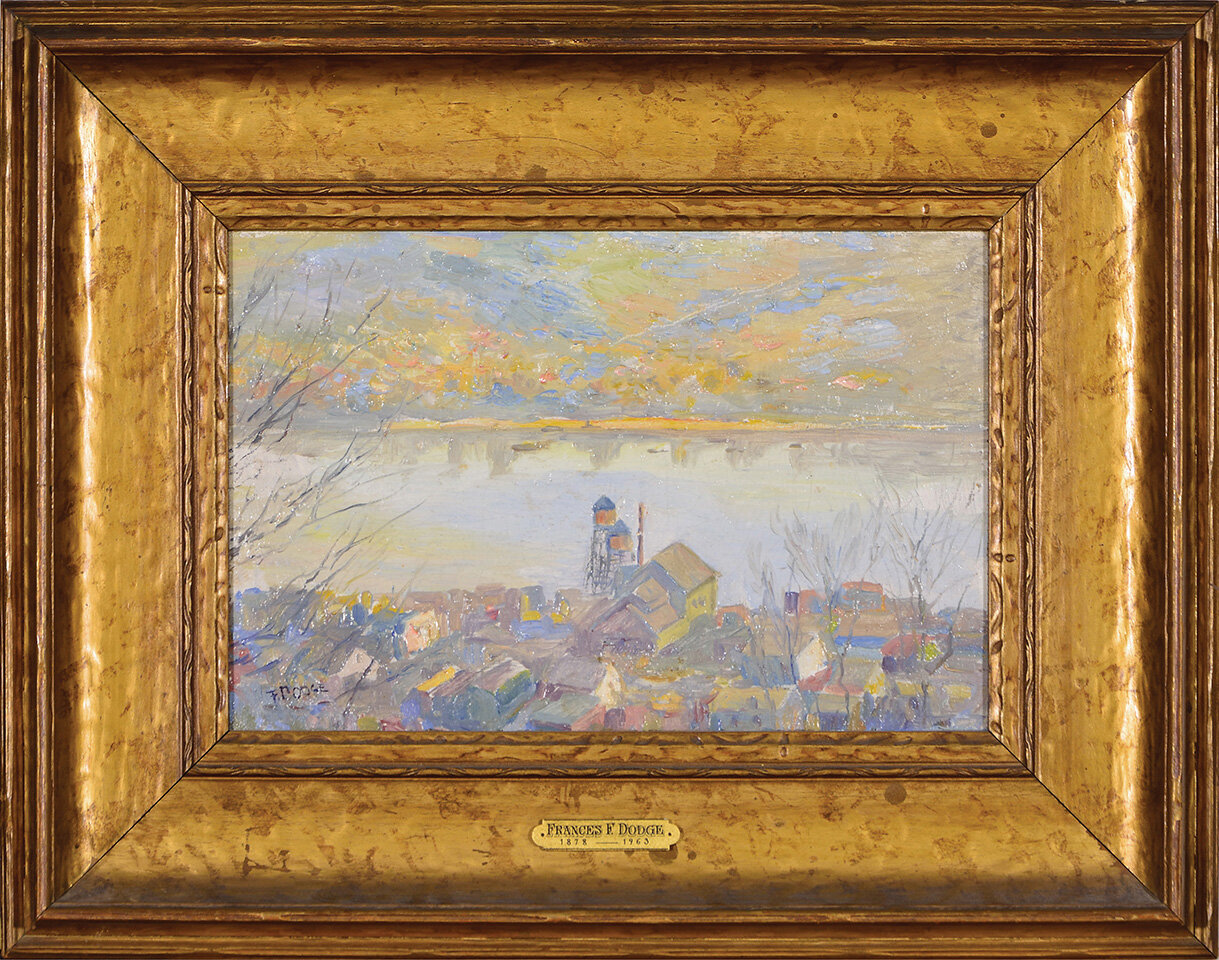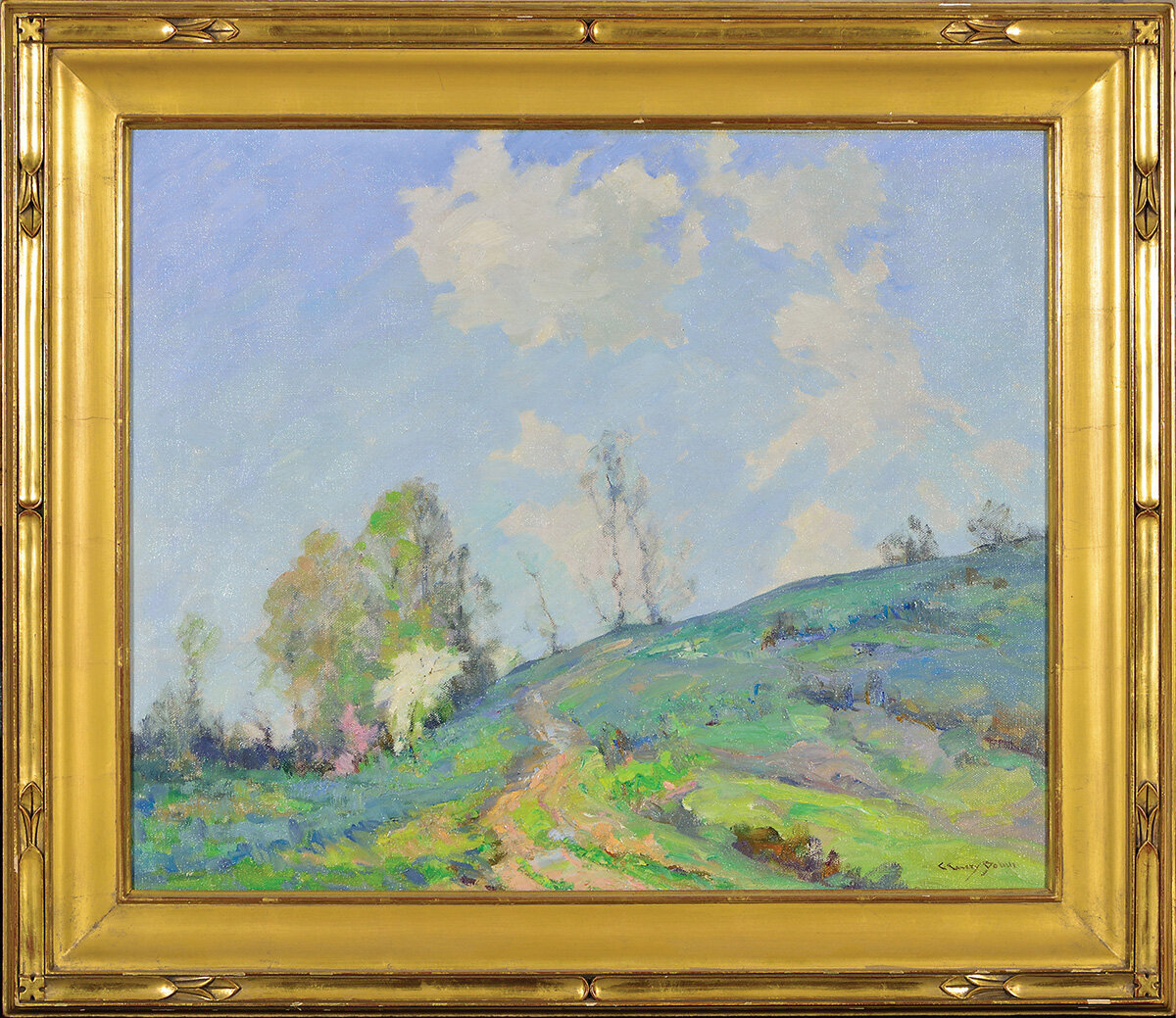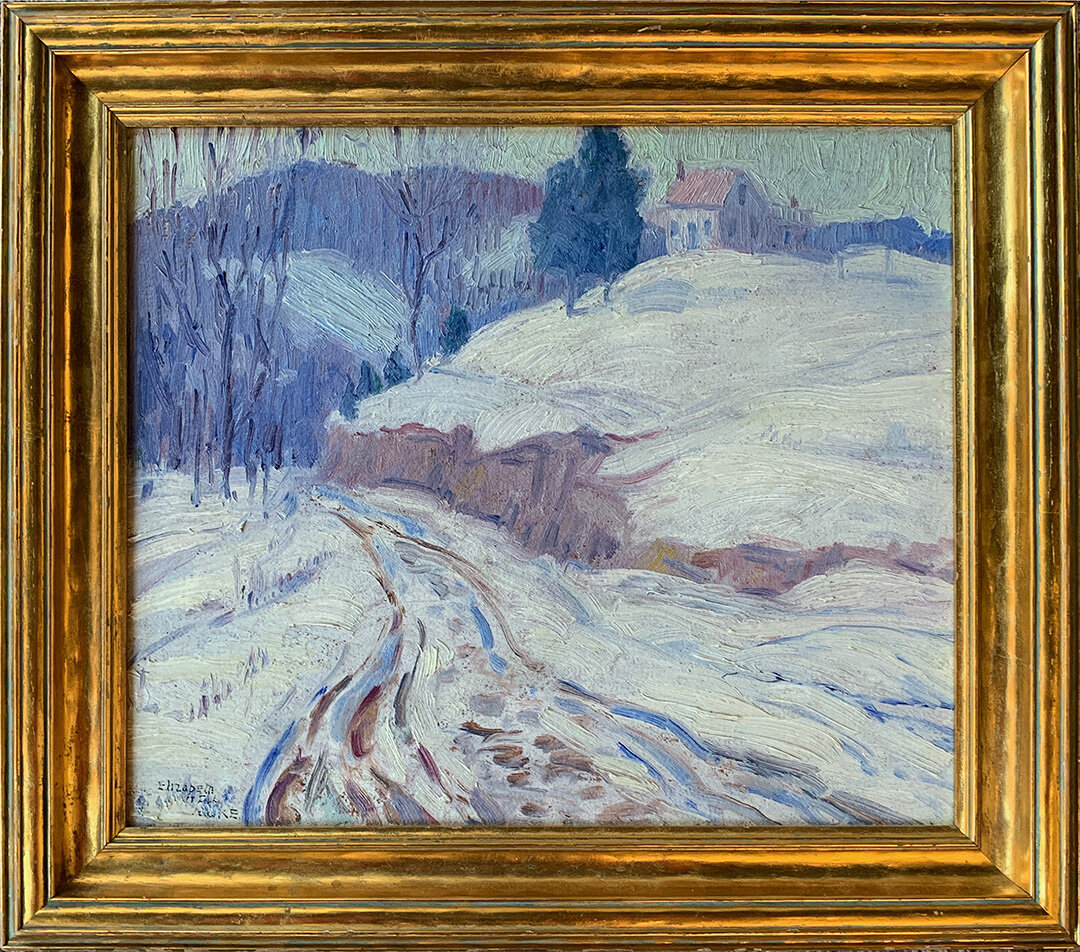Gustave Anthony Hugger
Gustave Anthony Hugger
Maypole Dance
Oil on Canvas
22 x 16 inches
Signed Lower Right
ID: DH2311
This following biography was researched, compiled, and written by Geoffrey K. Fleming, Executive Director, Huntington Museum of Art, Huntington, WV.
GUSTAVE ANTHONY HUGGER (June 22, 1869 – April 25, 1951)
A.K.A. “Gustav Hugger”
Poster artist and landscape painter in oil. Born in Cincinnati, Ohio, the son of Helena Schmidt (1843 – 1916) and Christopher Hugger (1835 – 1909). His father was born in the Kingdom of Wurttemberg and was a cabinet maker who resided with his family in the 19th ward of Cincinnati.
Gustave Hugger was educated locally and probably studied with Frank Duveneck (1848 – 1919) in Cincinnati, though that has not yet been confirmed. He was already employed in Cincinnati as a lithographer when in 1892 he applied for a passport to travel to Europe where he noted he would be staying for up to two years. There Hugger attended the Académie Julian in Paris where he honed his artistic abilities. Following his return, he continued to work as a lithographer. In 1899 he married Sophie Juergens and soon they were ensconced in a home located on Jefferson Avenue in the 28th ward of Cincinnati.
In 1901 he is for the first time listed as a “poster artist” in the Cincinnati city directory. It is a profession he would follow for the remainder of his long life. Sometime not long after that date he is listed as a member of the Men’s Art Club of Cincinnati, which included many of Duveneck’s former students. The following year (1902) he exhibited three paintings – “April Showers,” “North River” and “Sunset” – at the Cincinnati Museum of Art.
Sometime between 1902 and 1908 Hugger and his wife moved to Cleveland, where he followed many other prominent artists, including Carl Moellmann (1879 – 1950) and William Sommer (1867 – 1949), in moving to the city “to work in the city’s booming lithography industry.” In Cleveland he is listed again as a poster artist residing in the 23rd ward of that city.
In addition to exhibiting works locally, Hugger submitted paintings to regional exhibitions as well, including at the Albright Art Gallery in Buffalo, New York. In 1908 he received praise for his submission to their annual exhibition, where reviewers noted: “Gustave Hugger has contributed a beautiful canvas, a water scene, boats lying off in the bay, while the shore in the background is misty, hazy, indefinable, but full of poetical beauty.” Later that same year at the Buffalo Society of Artists exhibition he received another positive review for his works: “On the same wall there is a particularly agreeable river effect by Gustave Hugger of Cleveland, and the same artist has an equally meritorious composition on the north wall…”
Along with several other important Cleveland artists, Hugger was greatly impressed with the works exhibited in 1910 by Abel Warshawsky (1883 – 1962), who had recently returned to Cleveland after three years of study in France, where he learned to paint “with pure, brilliant color inspired by the impressionists and post-impressionists.” Along with Hugo Robus (1885 – 1964), William Sommer and William Zorach (1887 – 1966), Hugger persuaded Warshawsky to hold group classes where they could learn from him. He became part of the “secessionists” artist group in Cleveland who were followers of Robert Henri (1865 – 1929) and were “sympathetic to experimental art.” He exhibited with the group in Cleveland at the Rorimer-Brooks Studios, the Taylor Gallery (in 1912 and 1914) and personally with Sommer and Warshawsky at the 1913 Kinney & Levan painting exhibition. Hugger may have continued to exhibit with the secessionists after they moved their exhibitions to Laukhuff’s Bookstore around 1916.
The exhibition that took place in 1914 at the Taylor Gallery was a major turning point for the secessionists, and was a reaction to the founding of the conservative Cleveland Society of Artists and their 1913 exhibition, which featured far more traditional fare. The Taylor exhibition featured works by American modernists, including paintings by Clevelanders Elmer Brubeck, Gustave Hugger, William Sommer, Abel Warshawsky and William Zorach which were hung with works by New York City modernists including Marsden Hartley (1877 – 1943), Abraham Walkowitz (1878 – 1965) and Max Weber (1881 – 1961). The show ended up being ridiculed by conservative Cleveland critics, called “all rot” by others and was further derided under the newspaper headline “Biggest Laugh in Town This Week Not in Theater, But Art Gallery.”
During World War I, many of the artists of German extraction working in Cleveland, such as Hugger, faced additional criticism and attacks, due to so many of their modernist ideals having been heavily influenced by writers, philosophers and artists back in Germany. Some changed the spelling of their surnames, others were ostracized. Following the war “many Cleveland artists abandoned experimental modernism for a more conservative approach,” with Charles Burchfield, who had arrived on the scene in 1914, even destroying nearly all of his early surrealist style works in favor of concentrating on those that more realistically depicted local scenes and subjects.
Hugger himself left Cleveland, heading to the east coast where he could work freely and not be restricted by the conservativism sweeping the art world in that city. By 1920 he and his family were residing on Palisades Avenue in West Hoboken, where he continued his work for a local printing company as a poster artist and designer. In 1930 they were in Union City, New Jersey, where he was working as a poster designer for an advertising company. With their last children finally out of the house, Hugger and his wife moved to Chester, New York, where he continued his work as a poster artist there for the Tooker Printing Company.
Gustave A. Hugger died in Middletown, New York on Wednesday, the 25th of April 1951 at the age of eighty-one years. It is not currently known from where his service was held or where he may have been buried.
As a painter, Hugger’s works are impressionistic in style and typically feature bright colors regardless of whether they date to the early or latter part of his career. Many of his late works depict the rural scenery near his home along Sugar Loaf Road in Chester, New York. And although he spent nearly his entire career employed as a designer of posters, so far no example of his poster work has been definitively identified. His paintings are most often signed either “Gustave Hugger” or “G. Hugger.”
Though there are undoubtedly other exhibitions in which Hugger participated, those presently known include the following: Cincinnati Museum of Art, Cincinnati, OH, 1907; Albright Art Gallery, Buffalo, NY, 1908; Buffalo Society of Artists Thumb-Box Exhibition, Buffalo, NY
1908; Rorimer-Brooks Studios, Cleveland, OH, c. 1911-18; Taylor Gallery, Cleveland, OH, 1912, 1914; Rowfant Club, Cleveland, OH, (probably), c. 1912; Painting Exposition, Kinney & Levan, Cleveland, OH, 1913; Men’s Art Club of Cincinnati, Cincinnati, OH, (u.d.); Kokoon Arts Club, Cleveland, OH, (u.d.); Laukhuff’s Bookstore, Cleveland, OH, (possibly, u.d.).
Hugger’s works are currently known to be in the collection of the following public institutions: Kokoon Arts Club, Cleveland, OH. His works also reside in many private collections throughout the United States.





